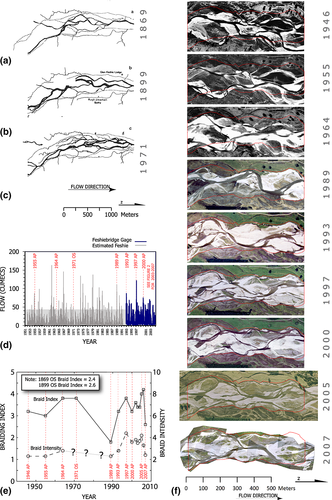Module 7 - Topographic Changes
See Corresponding Learning Module
Go to the learning module for this topic.
The Set-Up
 We will take you to the Highlands of Scotland, to the River Feshie to help you become familiar with quantitative analysis of channel geometry changes (the subject of Chapter 6). In the figure at right from Wheaton et al. (2013) we can see a braided gravel bed river actively adjusting through time. You will be given access to topographic surveys from 2003, 2004, 2005, 2006 and 2007 of this reach.
We will take you to the Highlands of Scotland, to the River Feshie to help you become familiar with quantitative analysis of channel geometry changes (the subject of Chapter 6). In the figure at right from Wheaton et al. (2013) we can see a braided gravel bed river actively adjusting through time. You will be given access to topographic surveys from 2003, 2004, 2005, 2006 and 2007 of this reach.
In the book, your authors talk about bed and bank processes that influence channel shape. You will zoom in and look directly at such changes to a real river, and use a tool, the Geomorphic Change Detection Software to analyze it quantitatively.
Purpose
The goals of this assignment is to i) give you experience working with topographic datasets (that capture channel geometry), and ii) help you recognize and identify specific mechanisms of geomorphic change from repeat topographic datasets. These concepts were cast in Chapter 7 as "Channel Geometry" changes and here we will unpack that a little more with topographic analysis.
Prerequisites
Students/Participants are expected to have some previous GIS experience, familiarity with ArcGIS (don’t need to be an expert), and some understanding of topographic data and digital elevation models.
Note: If it's been a while since you've used ArcGIS and you want a refresher, you may find these Getting Organized and Oriented pages helpful, or you may find Task 1 of this Intro to GIS Lab Exercise helpful (don't bother with the making a website portion; Task 2 and 3).
Computer & Software Requirements:
- All students/participants will need access to a computer with ArcGIS 10.6 or later (QCNR and Engineering Computer labs have this)
- If you use your own computer, it will need a Windows OS (Windows 10 recommended)
- For ArcGIS to run efficiently in Windows, 8 GB or more of RAM is recommended
- A mouse is strongly encouraged over a trackpad
- Required Software:
- GCD Add-In (Requires ArcGIS 10.6 or later)
- NOTE: If you are working in a computer lab, you CAN install this Add-In, but may need to reinstall it each time you come to the lab.
- If you need a Education Edition license for a new or existing installation of ArcGIS, email Joe.
The Assignment
Part 1 - Get Ready For Monday - Build Project & Do Some Budget Segregation
For the first part of this assignment, I want you to do:
- 1.A Download the Feshie Data (also below)
-
- B Create a GCD Project (you will bring this to class on Monday and turn this in for Part 2) with at least:
- 1.B.1: Three of the Five years loaded as surveys (see videos for how to do error modelling)
- 1.B.2: Two change detections (threshold @ 80% probability) for two of the epochs
- 1.B.3: A budget segregation with at least two examples each of the following mechanisms of change identified:
- Bank Erosion
- Channel Bed Lowering (degradation / incision)
- Channel Bed Rising (aggradation)
- Bar Development
Come to class with your GCD project handy to show, and your list of questions and/or problems you encountered. You will work on small groups and share your projects, and explain what you found.
Concepts to Illustrate & Explain
Building your GCD Project. In this tutorial, I show you how to get through 1.B.1 and 1.B.2 above.
Doing Budget Segregation. In this tutorial, I show you how to get through 1.B.3 above.
For more information on budget segregation, see the following GCD Tutorials:
Part 2 - Turn in a Web Page
You will prepare a web page explaining what you did and defending your interpretations. Please include clear annotated figure(s) and/or video showing the identification two examples each of these four mechanisms:
- Bank Erosion
- Channel Bed Lowering (degradation / incision)
- Channel Bed Rising (aggradation)
- Bar Development
If you opt not to use video, please instead describe with text what you interpreted and justify your interpretation.
Resources
Dataset
Dataset

River Feshie, Scotland, UK
A 700 m long braided reach. Dataset.
Dataset includes:
- 700m braided gravel bed river in the 📍 Scottish Cairngorm mountains
- 5 annual surveys
- Mix of RTKGPS and Total Station
- 1m cell resolution
Relevant Paper
The work we will do on "budget segregation" is based on Wheaton et al. (2013):
- Wheaton JM, Brasington J, Darby SE, Sear DA, Vericat D‡., and Kasprak A. 2013. Morphodynamic signatures of braiding mechanisms as expressed through change in sediment storage in a gravel-bed river. Journal of Geophysical Research - Earth Surface. DOI: 10.1002/jgrf.20060.
Album
Here is a Google Album of the Feshie to get a better feel for the site.
More Background on GCD
We have taught numerous courses and workshops on GCD. The following resources might be helpful if you want a deeper treatment of the methods and topics: